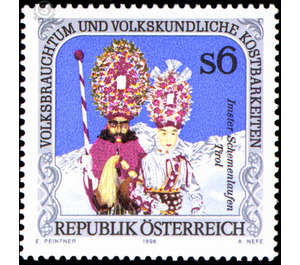folklore - Austria / II. Republic of Austria 1996 - 6 Shilling
Theme: Art & Culture
| Country | Austria / II. Republic of Austria |
| Issue Date | 1996 |
| Face Value | 6.00 |
| Color | multi-colored grey |
| Printing Type | combination printing |
| Stamp Type | Commemorative |
| Item Type | Stamp |
| Chronological Issue Number | 1520 |
| Chronological Chapter | OOS-OE2 |
| SID | 348510 |
| In 63 Wishlists | |
The Imst Scheme Run is one of the most famous carnival customs in the Alps. But there are only guesses about its origin. The modern folklore sees in the Schemenlauf a "practiced since the late Middle Ages merriment" before Lent. Although the spectacle was even banned at the time of the Counter Reformation and during the Enlightenment, thanks to the strong tradition of Tyrolean tradition, it has been preserved to this day and succeeds successfully against the commercialization of the mass media. The brand image shows the two main characters, the bizarre "Scheller" with a monstrous mustache, and his feminine counterpart, the "Scooter". They form a circle around which the other figures are grouped: "Sackner", "Wigligsackner", "Turesackner", "Bauresackner" and the "splashes", which provide space for the whole thing with cold water. Another key element is the witches, bird dealers and "Ruaßler". After the Fassnachtsmesse in the morning, the "lift" of the masks starts from the Lower Town to the Upper Town. The "move" in the opposite direction then begins with the "twelve-o'clock peal" and in the evening "praying" the whole haunt is put an end.


